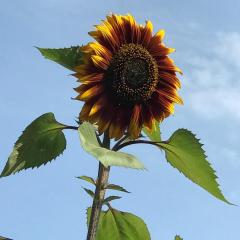
Jenni
participating member-
Posts
1,040 -
Joined
-
Last visited
Contact Methods
-
Website URL
http://riceandspicy.blogspot.com/
Recent Profile Visitors
4,338 profile views
-
I suppose you're talking about shop bought fried tortillas then? If we're comparing a factory made product with something freshly made at home with raw ingredients, then I would rather have the home made stuff, it's true. That wasn't explicitly stated in the OP's post so I didn't think of it. If we are just talking tortilla chips vs. plaintain chips then you're not comparing a fresh vegetable with processed food - you are comparing fried vegetable (well, fruit) with fried grain-that-came-from-a-plant-and-is-not-inherently-bad. According to wikipedia, plantain has less protein and fibre than maize. It does have more potassium, vitamin a and vitamin c, but I don't know how well those things survive deep frying. Also, I think that's completely besides the point. We are talking about two starchy deep fried things, both tasty. Pick one and be happy to eat it, but don't kid yourself that you're making a hugely significant health decision.
-
Plantains are a highly starchy food and I think it's a bit silly to say "Oh but it's a fruit so it must be healthier!" I happen to think that both corn and plantains can be a perfectly fine as part of a nutritious diet and I do not believe in low or no carb diets, so please don't feel I am saying plantains are unhealthy because they are starchy. It's just that it seems foolish to me to think that there is a major major difference between deep fried plantain and deep fried tortilla in terms of nutrition.
-
I'm confused as to why fried plantain chips would be more acceptable than fried tortilla chips? Both are mostly starch and deep fried. Personally, I have no objection to either, but I'm just trying to understand the logic here.
-
Yes! Although actually, the starting point for real ghee is collecting the cream that forms on top of the yoghurt each day and setting it aside until you have enough to churn into butter. Some people use the cream that forms on the top of boiled milk and add a little yoghurt to that to culture it, but I prefer the yoghurt cream method.
-
Very interesting, and beautiful pics as always. Sadly for me I don't own a dehydrator, but it's good to see someone else having fun with one. Do you reckon I could have a go at sun drying instead? It's 44°C degree today so it seems possible - and it's gone up to 47°C on some days. In your opinion, are there any fruits that don't work very well as fruit leather? Which ones are particularly good? Mangoes are cheap and luscious at the moment so they seem an obvious choice. The only problem would be preventing myself from eating most of them whilst preparing them to be dried. Have you ever tried veggie "leather", or is that weird? Ok, it sounds weird, but I am curious about it!
-
I love beetroot in raita. A number of seasonings go well with it. A favourite of mine is to heat some oil or ghee and add mustard seeds plus a pinch of hing. Sometimes I also add urad dal and cumin seeds. When the seeds pop, I add curry leaves and minced green chillies, swiftly followed by grated beetroot plus a bit of salt, and stir it around until the beetroot is wilted but still retains some texture. Then I cool it and mix with yoghurt, adjusting salt to taste. I always added chopped coriander to this, but also sometimes mint. And sometimes I add garlic to the seasoning, just before the beetroot, as garlic-beetroot-yoghurt-mint is a heavenly combination. Another dish I like to make is good for breakfast. It's a poha dish. Poha is beaten rice, that is to say rice that is beaten flat. It cooks very quickly. It comes in different thicknesses, and for this dish you need the "mota" or thick kind. Rinse it gently and leave it in a seive. For four people you need around 2 cups (of 250ml size). Meanwhile, peel and grate the raw beetroot and chop up some onion and mince some green chillies to taste. Quantities of all this is up to you. You just need one onion, and Indian onions are smaller so don't use a huge one. They are also reddish in colour but not like red onion in taste. Number of beetroot will depend on size and preference. But there should be enough vegetable for taste, without drowning the dish as it is a starch dish not a veg dish. Heat some oil, preferably coconut, in a pan (just 1-2 tablespoons is plenty for four people), and when hot add urad dal, followed by mustard seeds and cumin (about 1 tsp each) plus a pinch of hing. For variety, you can also make it with 1 teaspoon each chana and urad dal, but no cumin. When the dal reddens and the mustard pops, add minced green chillies, curry leaves and onion. Stir and fry for a bit, then add grated beetroot and salt. Stir and fry until cooked but still with texture. Add the poha and stir and fry gently to combine it well and cook the poha. It just takes a few minutes. Check for salt while you are at it. There should be enough moisture in the dish already, but if not you can sprinkle a little water. But the end dish should keep the shape of the poha and be tender but not mushy so don't add a lot. Finally, add as much grated fresh coconut as you like (at least 1 tablespoon per person), and some chopped fresh coriander (just 1-2 tablespoons is fine) and stir it in. I love to eat this with a chutney with a sour and chilli kick to it. It's also good with plain yoghurt. Or if you have nothing like that on hand, just squeeze a little lemon juice over your serving.
-
How To Handle Excessively Loud (obnoxious) Diners at the Next Table
Jenni replied to a topic in Restaurant Life
For restaurants it's a difficult situation. Whatever they do, they risk upsetting a customer. Personally, I would first try to discretely ask management at the restaurant if there is anything that could be done. For instance, if they won't say anything to the party making all the noise, then maybe they might move my party? If they say "Sorry, we really can't do anything." then next I would consider going up to the noise-makers and politely asking if they might try to keep it down a little. It's astonishing how some people do not realise the way they effect others around them, but if you are polite they do sometimes try to tone it down. -
My Dad taught me butter and marmite...
-
Hmm...I think if it didn't look particularly good on the outside when you looked at it in the store, then you can't really fault the store for the fact that you still chose to buy it. In the UK, I was often shocked by some of the terrible looking fruit and veg that Tescos tried to sell. However, I often saw people buying it! I suppose some people just don't care. Also, sometimes older stuff is sold off cheap so that's probably a factor for some people. I always selected the best looking stuff, and if I saw a tray of nasty looking items I would alert a member of staff and ask if they had anything in better condition out back.
-
Really? Can't speak for London but in Bristol every supermarket had them when I was last there.
-
Emily_R, you are reminding me of a Madhur Jaffrey recipe from her World Vegetarian book that has similar flavours. I don't have access to the book right now but I remember lightly cooked courgette cooled and mixed with olive oil, lemon, dill and feta. There may have been a few other ingredients, I can't remember. I used to make it quite often in the Summer, very delicious.
-
Whilst it's true that you can add wheat flour to bajra, jau, jowar, ragi and makki breads, you certainly do not have to and I never do. It requires more skill to form the breads (I form them by hand - with skill you can get them just as thin and perfectly shaped as if they were rolled) but they come out with a wonderful taste and texture.
-
Apparently my childhood should have killed me - I remember summer days of picking blackberries straight of the bramble and eating them, and "pick-your-own" raspberries and strawberries was mostly about how many you could eat on the way round!
-
What roti are you referring to? In Hindi, roti just means bread. So in India the term can be used to refer to breads in general or sometimes it can be part of a bread name such as makki ki roti, which is roti made from maize. Other times people say roti to indicate chapati. Outside of India the term roti can imply something similar but with a regional twist. For instance in Trinidad there are various roti that are somewhat similar to Indian breads but made with white flour instead of ata. Going back to India to answer your besan question - there are indeed breads that use some besan in the dough. A well known variety is called missi roti. It has ata, besan and spices in the dough and is very tasty, often considered a Winter food as it is a little heavier and more warming than plain roti. But I don't believe I've ever come across a roti made only from besan. Besan does not have gluten and I think it would be difficult to knead and form into a good bread. Of course there are roti made from non-gluten flours (jau, jowar, bajra, ragi, makki) but somehow besan is different and isn't used in the same way. I guess maybe because it's a legume and not a grain? You can make something bread-like using only besan though - besan ka chilla/ cheela, also called pudla or poora in some languages. This is a sort of pancake made with a batter of besan with spices and sometimes vegetables. It's very quick to make and quite healthy, I like them for breakfast. Hope this helps a bit!
-
I've eaten a couple of Iranian style rice dishes with dill in them, amongst other herbs I think. Very very good. Dill is also used in a number of Indian cuisines as a vegetable. Because of its distinctive aroma and taste, not everyone likes it! In Allahabad, it is often sold in combination with methi (fenugreek greens) and a common recipe is to cook it as a dry sabzi (vegetable dish) with potatoes (either along with the methi or without). There's also a famous Sindhi dish called sai bhaji which is a mixture of vegetables cooked with greens and chana dal until tender and then mashed. The dill in it gives a distinctive flavour. One of the dishes I make most commonly with dill is a chana dal khichdi (rice and dal dish) with dill as the main vegetable and cumin, hing, tomatoes and garam masala used in the tadka. Another dish is toor dal with dil. For this the toor dal is pressure cooked and then the dill and some chilli powder is simmered in it until done, before a tadka of mustard seeds, cumin seeds, hing and garlic is given. Both of these dishes are divine with a good squeeze of lemon.



